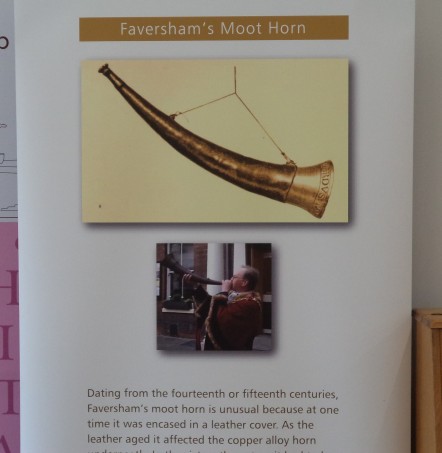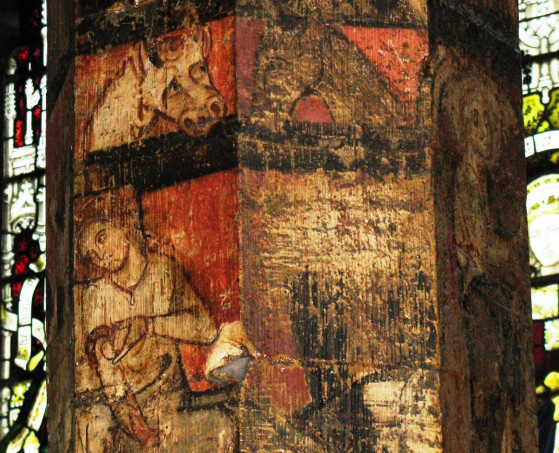This week I want to highlight some forthcoming events, starting with the Annual Becket Lecture, which is next Tuesday 14 May at 6pm (drinks reception from 5.30pm). Professor Elisabeth van Houts (University of Cambridge) will give this FREE public lecture on ‘Empress Matilda (d. 1167) and Archbishops in Twelfth-Century Germany, France and England’. The Lecture will be in The Michael Berry Lecture Theatre, Old Sessions House, CCCU CT1 1PL. We are delighted to welcome Professor van Houts to Canterbury, and all are welcome to attend, booking not required.

Turning to this week, on Wednesday 8 May Professor Jackie Eales gave the last of this season’s monthly Canterbury Historical and Archaeological Society lectures in St Paul’s church. Her talk, entitled ‘The butcher, the baker and the candlestick maker: who lived in Canterbury in 1641?’, explored Canterbury society in the prelude and during the First English Civil War, taking as its starting point the 1641 poll tax. She also drew on other national, as well as local records, although probably one of the most interesting remains the detailed map (CCAL: Map 123) of the liberty of Canterbury seemingly produced in about 1640. So she introduced us to certain gentlefolk who resided in the city, members of the mayor and corporation, clerical personnel from the cathedral and parish churches, as well as those who might have been seen or seen themselves as members of the ‘middling sort’. Of course, one of the events Canterbury is often remembered for is the Christmas Day riots of 1647, but there were people on the two differing sides, albeit as far as Kent is concerned the only battle of any real significance, and then not great, took place in Maidstone. Whereas it was Canterbury Cathedral that probably sustained the greatest damage in terms of the Puritans, especially such matters as the breakage of the stained glass windows and the font. This was an interesting talk and we’ll be staying with the 17th century tomorrow.
For on Thursday 9 May at 5pm it is the Renaissance Lecture under MEMS at the University of Kent. This year the speaker is Professor Kenneth Fincham and his subject is ‘Charles II: Conformity, Toleration and Supremacy’ where he will explore Charles II’s active supremacy, the problems the king faced in handling religious pluralism and the mixed success that he enjoyed. As Professor Fincham says, “Charles II is often regarded as a ‘merry monarch’ or as a devious and cynical politician, who wore his religion lightly. Yet it can be argued that the king took the politics of religion extremely seriously, especially during the return of the episcopalian church of England in 1660-3. A recently discovered royal declaration of November 1661 throws new light on his views and aspirations, including the pursuit of religious toleration through extending his powers as supreme governor. Yet paradoxically Charles II was a staunch episcopalian in his public profession of religion. The lecture will explore Charles II’s active supremacy, the problems he faced in handling religious pluralism and the mixed success that he enjoyed.” For more details of this free, public lecture, see: https://www.kent.ac.uk/events/event/66238/renaissance-lecture-2024 .

Saturday 11 May offers something different in that the Ash Heritage Group are having an ‘Open Morning’ at Ash Village Hall between 10am and midday. At this free event, people will be able to watch films from ‘Bygone Ash’, browse the extensive display of treasures from the Ash Heritage Centre archive, as well as find out about the work of this Heritage Group who are seeking to preserve the history of Ash. All welcome.
For next week, as well as the Annual Becket Lecture, there are two further lectures involving staff from CCCU. Firstly, on Monday 13 May the next free lunchtime talk at the Kent Archives will be me speaking on ‘Rethinking mayor-making and other civic rituals in medieval times at the Kentish Cinque Ports’. This talk will be at 1pm at the Kent History and Library Centre, Maidstone, taking as its premise that civic elections have for centuries been valued by towns as a means to demonstrate their collective identity. The Cinque Ports as a group were at the forefront of such developments, frequently recording such details at the beginning of their custumals. My talk will explore these civic ceremonies which may have been in operation from as early as the 13th century and although I’ll be drawing on evidence from a broad range of Ports, the fullest evidence comes from Dover and Sandwich. Furthermore, we’ll also investigate the holding of courts in these Ports, another role which offered the authorities opportunities to enhance the town’s identity; as did civic pilgrimages, the third section of my talk. To book a place, please email archives@kent.gov.uk or phone 03000 420673.

Also next week, we have on Thursday 16 May at 7pm in Newton, Ng07, CCCU campus, the joint CKHH and FCAT lecture to be given by Dr Catriona Cooper (Senior Lecturer in Digital Humanities, CCCU). Entitled ‘Beyond the visual: digital sensory past’, Dr Cooper will examine how digital approaches have opened up routes into exploring sensory pasts in new and exciting ways. Her talk will discuss two approaches to opening up our understanding of sensorial experience of the past: auralisation and 3D printing, using case studies from Kent and further afield. All are welcome and the lecture is free to students.
Turning to other matters, it was the online ‘catch-up meeting’ of the Kent History Postgraduates this week, and next month we’ll be having two presentations, early in month it will be Lizzie Burton and then later in June Kieron Hoyle will be speaking, and in between these two presentations, three of these postgraduates will be leading a session at the University of Kent’s MEMSFest. It is a few years since another group led a session there and it is good to see CCCU historians back at Kent again. This time there will be a greater emphasis on the early modern and cultural urban history, and hopefully the team will enjoy the experience and gain plenty of helpful feedback. Of those at the meeting this week, all except Kieron are in the final months before submission and therefore are extremely busy either writing the last of their chapters or reworking their introduction etc. Although exciting, it is also quite a fraught time, so many thanks to all for giving up valuable writing time to join the group discussion.
Finally for this week, I thought I would include a short piece I was asked to provide for the programme for ‘Noye’s Fludde’, a community opera by Benjamin Britten that was performed at St Mary of Charity parish church in Faversham last week on the 25th and 26th April. The performance by Faversham Youth Arts under its Artistic Director Ben Saul featured schoolchildren from Ethelbert Road Primary School, St Mary of Charity Primary School, Lorenden Primary School, Ospringe School, and Bridge and Patrixbourne School under their chorus mistress Helen Brookes. The music was provided by the youth orchestra which joined the main orchestra, and the principal singers included the four soloists, Simon Thorpe as Noye, Helen Vincent as Mrs Noye, Philippa Jevons as God and Mark Bateson as God.

Sadly, I wasn’t able to get to either of these performances, but it was great to be able to contribute just a little towards this excellent production. So here you are on ‘The centrality of Mary and the Holy Family at St Mary of Charity, Faversham’: From the grant of William the Conqueror until the abbey’s dissolution by Henry VIII, St Augustine’s Abbey in Canterbury held the patronage of Faversham’s sole parish church. Dedicated to St Mary/Our Lady, the late medieval testamentary records offer a wealth of information about the many Marian devotional places in the church and churchyard: to the north of the church a separate chapel dedicated to the Trinity and Our Lady, on the south side one to Our Lady. Inside the church there was the parish’s patronal Marian image, a second as part of the Rood, Our Lady of Pity, Our Lady in the Nave, Our Lady in the Choir, the Assumption of Our Lady (also in the choir), and Our Lady of/in Gesyn.
The Holy Family, too, were well represented, the image of St Anne in the south aisle surrounded by candles was close to Our Lady of Pity, both images cared for by a brotherhood comprising some of the parishioners, who may have celebrated Mass there each week: Robert Fale (1530) bequeathed a penny a week for three years. In the north aisle, probably in the transept was the altar and image of St John the Baptist. Close by was Faversham’s ‘painted pillar’ as well as other decorated pillars (there are traces of paint), perhaps showing scenes from Mary’s life. The wills do not mention the location of Our Lady of Gesyn (Elizabeth Overton referred to her as ‘Our Lady of Bedlam’/Bethleham), but the west-facing side of the ‘painted’ pillar’ offers a highly suitable place for such an altar. At the top is the Crucifixion, the middle shows the Nativity: Mary suckling Christ as she half reclines on a couch or childbed, watched over by the ox and ass, while the bottom tier, as part of the Adoration of the Magi, depicts the crowned Virgin as Queen of Heaven staring out at the viewer, the Christ child on her knee. This direct engagement between viewer and viewed, whether solely among the painted figures or as here between St Mary and medieval parishioners, highlights the artist’s (and patron’s) sophistication, such ideas used later in biblical drama, especially the York ‘Crucifixion’. There may have been a similar dramatic tradition in late medieval Faversham and, just as today, biblical plays can give an immediacy for both players and audience.
And next week it will be great to be able to report on the Professor van Houts’ Becket Lecture, like the History Week a highlight of the CKHH year.
 Centre for Kent History and Heritage
Centre for Kent History and Heritage Sheila Sweetinburgh
Sheila Sweetinburgh 1181
1181


